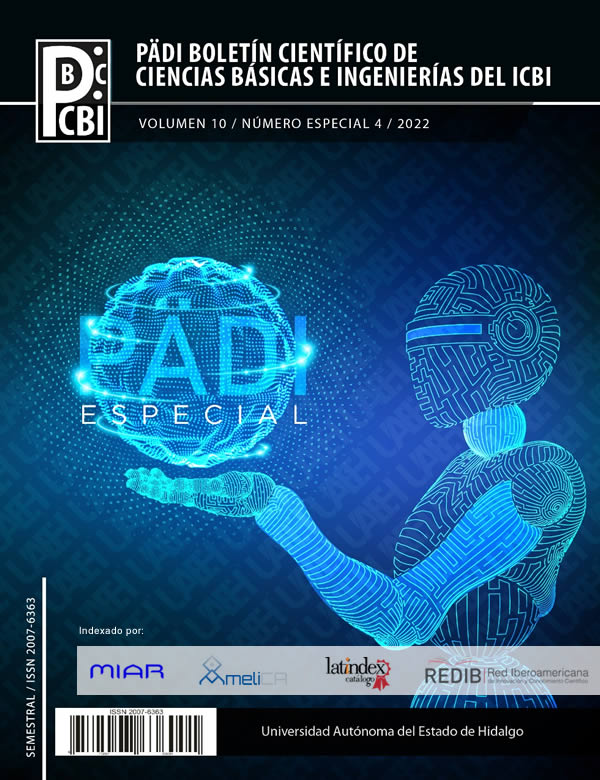Recognition and estimation of relative position of objects in controlled environments
Abstract
This project presents a system for recognition and classification of objects that are in its environment, for an assistance robot, as well as the estimation of their relative position with respect to the robot. For the recognition and classification of objects, we apply artificial vision techniques based on semantic segmentation tools, such as convolutional neural networks. For the estimation of the relative position of the objects, once identified, a stereoscopic vision technique was implemented. The results of the experiments show a 90.6% accuracy in recognition and classification, and an average error of 5 cm when estimating the relative position of the objects.
Downloads
References
Diddeniya, S. I. A. P., Adikari, A. M. S. B., Gunasinghe, H. N., Silva, P. R. S. D., Ganegoda, N. C., and Wanniarachchi, W. K. I. L. (2018). Vision based office assistant robot system for indoor office environment. 3rd International Conference on Information Technology Research (ICITR).
Emani, S., Soman, K., Sajith, V., and Adarsh, S. (2019). Obstacle Detection and Distance Estimation for Autonomous Electric Vehicle Using Stereo Vision and DNN. In: Wang, J., Reddy, G., Prasad, V., Reddy, V. (eds) Soft Computing and Signal Processing. Advances in Intelligent Systems and Computing, 898:639–648.
Ferreira, L. (2013). Localization and navigation in an autonomous vehicle. Universidade de Aveiro Departamento de Electrónica, Telecomunicaciones e Informática.
He, K., Zhang, X., Ren, S., and Sun, J. (2016). Deep residual learning for image recognition. 2016 IEEE Conference on Computer Vision and Pattern Recognition (CVPR), pages 770–778.
Jishnu, K., Indu, V., Ananthakrishnan, K., Amith, K., Reddy, P., and Pramod, S. (2020). Voice controlled personal assistant robot for elderly people. Proceedings of the Fifth International Conference on Communication and Electronics Systems (ICCES 2020), pages 269–274.
Levenberg, K. (1944). A method for the solution of certain non-linear problems in least squares. Quarterly of Applied Mathematics, 2(2):164–168.
Marquardt, D. (1963). An algorithm for least-squares estimation of nonlinear parameters. SIAM Journal on Applied Mathematics, 11(2):431–441.
Miseikis, J., Caroni, P., Duchamp, P., Gasser, A., R. Marko, N. M., Zwilling, F., Castelbajac, C., Eicher, L., Fruh, M., and Fruh, H. (2020). Lio-a personal robot assistant for human-robot interaction and care applications. in IEEE
Robotics and Automation Letters, 5:5339–5346.
Mukherjee, A., Adarsh, S., and Ramachandran, K. I. (2020). Ros-based pedestrian detection and distance estimation algorithm using stereo vision, leddar and cnn.
Purwanto, D., Rivai, M., and Soebhakti, H. (2017). Vision-based multi-point sensing for corridor navigation of autonomous indoor vehicle. International Conference on Electrical Engineering and Computer Science (ICECOS),
pages 67–70.
Rahul and Nair, B. B. (2018). Camera-Based Object Detection, Identification and Distance Estimation. 2018 2nd International Conference on Micro- Electronics and Telecommunication Engineering (ICMETE), pages 203–
Ronneberger, O., Fischer, P., and Brox, T. (2015). U-net: Convolutional networks for biomedical image segmentation. Medical Image Computing and Computer-Assisted Intervention, 9351.
Scipy (15 julio 2022). scipy.optimize.curve fit. API reference. https://docs.scipy.org/doc/scipy/reference/generated/scipy.optimize.curve fit.html.
Sensio, J. (3 octubre 2020). Visión Artificial - Segmentación Semántica. Sensio Inteligencia Artificial. https://juansensio.com/blog/050 cv segmentacion.
Yang, G., Wang, S., and Yang, J. (2019). Desire-driven reasoning for personal care robots. in IEEE Access, 7:75203–75212.













